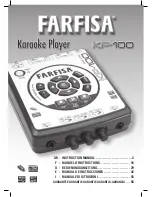
46131-0598 <90-00018>
P
AGE
23
7.
SELECT STOP BITS - Set for 1. Type 1 if the number of stop bits is
not set for 1. Changing the value, typing S or F, or pressing EN-
TER saves any changes and brings up the configuration screen.
8.
SELECT RTS/CTS HANDSHAKE - Default is 1 (OFF). Typing 2
enables RTS/CTS handshaking.
NOTE:
With DCP protocol, certain address combinations result in
reporting failures. The problem, a loss of synchronization in
the addressing sequence, is inherent in DCP.
Dantel recommends DCPF protocol because it maintains
synchronization.
Configuring a responder port for TBOS protocol:
1.
Type 2 from the configuration screen to display the responder port
prompts.
2.
SELECT PORT NUMBER - Type the port number to be config-
ured. Valid entries are 1, 2, or 4.
For the following selections, type S or press ENTER to skip to the
next selection, type F to save changes and exit the port configura-
tion, or type Q to quit the port configuration without saving any
changes.
3.
SELECT PROTOCOL - Set for TBOS. Type 3 if the protocol is not
set for TBOS.
4.
SELECT BAUD RATE - Enter the desired baud rate. Valid entries
are 1 = 300, 2 = 600, 3 = 1200, 4 = 2400, 5 = 4800, 6 = 9600.
5.
SELECT PARITY - Set for odd. Type 2 if the parity is not set for
odd.
6.
SELECT STOP BITS - Set for 1. Type 1 if the stop bits are not set
for 1.
7.
SELECT DISPLAY MAPPING INFORMATION FOR TBOS DIS-
PLAY # - Enter the type of alarm information the display will con-
tain. Valid entries are 0 = Off, 1 - 64 = TBOS Displays,
D = Discretes.
8.
SELECT RTS/CTS HANDSHAKE - Default is 1 (OFF). Typing 2
enables RTS/CTS handshaking.
Refer to the Configuration Worksheet (Table I) at the end of this
chapter to help configure the port.
Make an entry for each of the eight displays on the TBOS re-
sponder port. If a new value is entered, press the ENTER key.
At display 8, changing the value, typing S or F, or pressing ENTER
saves any changes and brings up the configuration screen.
9.
End of section.
INSTALLATION
















































